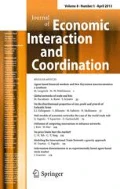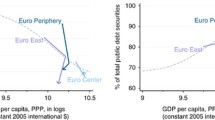Abstract
The objective of this paper is to evaluate the degree of financial integration achieved in the European Union based on covered interest parity and using Generalized Maximum Entropy. EU countries are divided into two groups according to their current situation with respect to the adoption of the euro. Financial integration before the adoption of the euro is analyzed for the countries that adopted the euro in 1999. Similarly, current financial integration is evaluated for non-euro EU countries. Besides the importance of comparing the situation of the non-euro EU countries with the situation of the euro EU countries previous to the euro adoption, which may be useful to evaluate an eventual decision of the non-euro members to adopt the euro, it is interesting to analyze the performance of Generalized Maximum Entropy. Generalized Maximum Entropy has the ability to estimate the parameters of a regression model without imposing any constrains on the probability distribution of errors and it is robust even when we have ill-posed problems. Overall our results suggest that the degree of financial integration on non-euro countries is lower than the degree of financial integration that existed among euro adopting countries before the adoption of the euro.
Similar content being viewed by others
References
Aliber R (1973) The Interest Rate Parity Theorem: A Reinterpretation. J Polit Econ 81: 1451–1459
Campbell R, Hill R (2005) A Monte Carlo study of the effect of design characteristics on the inequality restricted maximum entropy estimator. Rev Appl Econ 1: 53–84
Campbell R, Hill R (2006) Imposing parameter inequality restrictions using the principle of maximum entropy. J Stat Comput Simul 76: 985–1000
Csiszár I (1991) Why least squares and maximum entropy? An axiomatic approach to inference for linear inverse problems. Ann Stat 19: 2031–2066
De Haan J, Pilat D, Zelhorst D (1991) On the relationship between Dutch and German interest rates. De Economist 139: 550–565
Dickey D, Fuller W (1979) Distribution of the estimators for autoregressive time series with a unit root. J Am Stat Assoc 74: 427–431
Engle R, Granger C (1987) Co-integration and error correction: representation, estimation and testing. Econometrica 55: 251–276
Frankel J (1992) Measuring International Capital Mobility: A Review. Am Econ Rev 82: 197–202
Frankel J (1993) International monetary integration: relations between interest rates and exchange rates. In: Das D (eds) International finance—contemporary issues. Routledge, London
Fraser I (2000) An application of maximum entropy estimation: the demand of meal in the United Kingdom. Appl Econ 32: 45–59
Fratianni M, Wakeman L (1982) The law of one price in the eurocurrency market. J Int Money Finance 1: 307–323
Frenkel J, Levich R (1975) Covered interest arbitrage: unexploited profts?. J Polit Econ 83: 325–338
Frenkel J, Levich R (1977) Transaction costs and interest arbitrage: tranquil versus turbulent periods. J Polit Econ 85: 1209–1226
Golan A (2002) Information and entropy econometrics-editor’s view. J Econ 107: 1
Golan A (2004) Information and entropy econometrics—a review and synthesis. Found Trends Econ 2(1-2): 1–145
Golan A, Judge G (1996) Recovering information in the case of underdetermined problems and incomplete economic data. J Stat Plan Inf 49: 127–136
Golan A, Judge G, Miller D (1996) Maximum entropy econometrics—robust estimation with limited data. Wiley, London
Golan A, Karp L, Perloff J (1998) Estimating a mixed strategy: United and American Airlines. Institute for Research on Labor and Employment, working paper series, number 1018
Helmenstein C, Rünstler G (1996) Inflation and interest rate differentials between Germany and its EMS partners. Zeitschrift für Wirtschafts- u. SozialWissenschaften 116: 593–613
Herrmann S, Jochem A (2003) The international integration of money markets in the central and east European accession countries: deviations from covered interest parity, capital controls and inefficiencies in the financial sector. Discussion paper 07/03, Economic Research Centre of the Deutsche Bundesbank
Holmes M (2003) Monetary integration and the European Union: an assessment of the impact of capital controls, exchange rate turbulence and the introduction of the euro. Eur Rev Econ Finance 2: 3–18
Holmes M, Pentecost E (1996) Changes in the degree of monetary integration within the European community in the 1980s: some econometric tests. J Econ Stud 23: 4–17
Holmes M, Wu Y (1997) Capital controls and covered interest parity in the EU: evidence from a panel-data unit root test. Weltwirtschaflitches Archiv 133: 76–89
Jaynes E (1957) Information theory and statistical mechanics. Phys Rev 106: 620–630
Katsimbris G, Miller S (1993) Interest rate linkages within the European monetary system: further analysis. J Money Credit Bank 25: 771–779
Kullback S (1968) Information theory and statistics. Dover, New York
Lemmen J (1996) Monetary integration in the European Union—measurement and determination. Tilburg University: Center for Economic Research, Tilburg
Mansori K (2003) Following in their footsteps: comparing interest parity conditions in Central European Economies to the euro Countries. CESifo working paper no. 1020
Pukelsheim F (1994) The three sigma rule. Am Stat 48: 88–91
Said S, Dickey D (1984) Testing for unit roots in autoregressive moving average models of unknown order. Biometrika 71: 599–607
Scheicher M (2001) The comovements of stock markets in Hungary, Poland and the Czech Republic. Int J Finance Econ 6: 27–39
Shen E, Perloff J (2001) Maximum entropy and Bayesian approaches to the ratio problem. J Econ 104: 289–313
Shore J, Johnson R (1980) Axiomatic derivation of the principle of maximum entropy and the principle of minimum cross-entropy. IEEE Trans Inf Theory 26
Taylor M (1987) Covered interest parity: a high-frequency, high quality data study. Economica 54: 429–438
Vieira I (2003) Evaluating capital mobility in the EU: a new approach using swaps data. Eur J Finance 9: 514–532
Zellner A (1996) Models, prior information, and Bayesian analysis. J Econ 75: 51–68
Author information
Authors and Affiliations
Corresponding author
Rights and permissions
About this article
Cite this article
Ferreira, P., Dionísio, A. & Pires, C. Adopt the euro? The GME approach. J Econ Interact Coord 5, 231–247 (2010). https://doi.org/10.1007/s11403-010-0062-x
Received:
Accepted:
Published:
Issue Date:
DOI: https://doi.org/10.1007/s11403-010-0062-x




